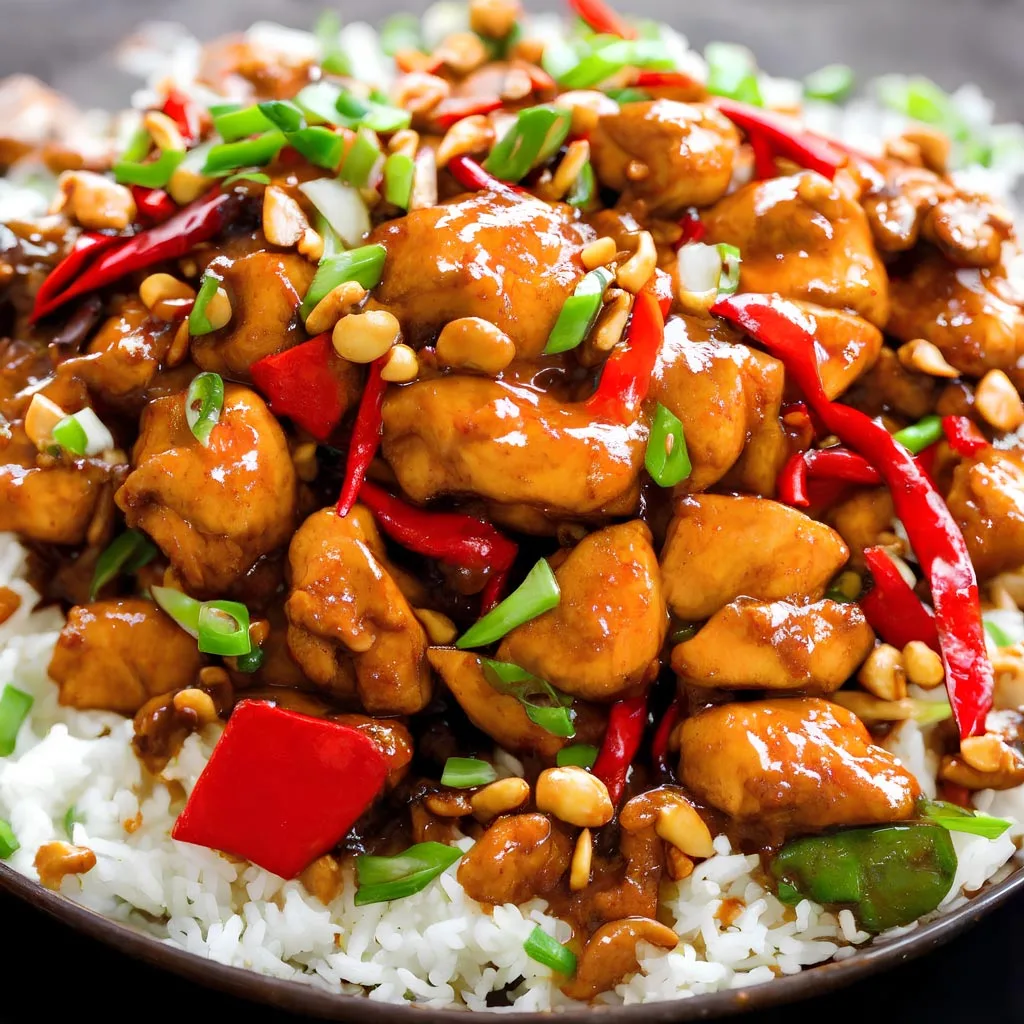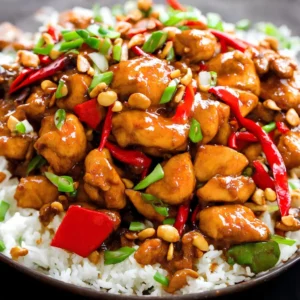
Kung Pao Chicken, a beloved dish in Chinese cuisine, brings together a tantalizing mix of flavors and textures that never fail to impress. Originating from the Sichuan province of China, this dish has made its mark on menus worldwide for its bold, spicy, and slightly sweet taste profile.
Despite its complex flavors, preparing Kung Pao Chicken at home is simpler than you might think, making it an excellent choice for both weeknight dinners and special occasions.
While some may find the name intimidating, fear not, for this recipe breaks down the steps into manageable tasks, ensuring that even beginner cooks can achieve culinary success.
Marinating tender chicken breast in a blend of soy sauce, rice vinegar, sesame oil, and honey infuses it with flavor and tenderness, setting the stage for the rich taste experience to come.
The magic truly happens when the marinated chicken meets the vibrant stir-fried vegetables and aromatic sauce, creating a symphony of flavors that dance on your taste buds.
With a touch of heat from red chili flakes and crunch from unsalted peanuts, each bite of Kung Pao Chicken offers a delightful balance of savory, sweet, spicy, and nutty notes.
Expert Tip: Adjust the amount of red chili flakes or dried red chilies according to your spice tolerance.
Chicken Breast: I choose chicken breast because it is lean, high in protein, and readily absorbs flavours. When marinated and cooked properly, it provides a tender, juicy bite. Alternative: If you want a richer flavour, chicken thighs would be a great substitute.
Soy Sauce: This gives the marinade and sauce a savoury, umami flavour. Its dark colour also gives the dish a beautiful hue. Tamari is an excellent gluten-free alternative.
Rice Vinegar: Its mild and slightly sweet flavour helps tenderize the chicken and adds a tangy note to the sauce. An alternative could be apple cider vinegar or white wine vinegar.
Cornflour: It helps to tenderize the chicken, give it a smooth texture, and thicken the sauce, making it cling to every piece. You could replace it with potato starch or all-purpose flour.
Sesame Oil: This adds a subtle, nutty flavour to the marinade and sauce. Alternatives could be light olive oil or peanut oil.
Honey: It gives a natural sweetness to balance the savoury and spicy elements. Maple syrup or brown sugar can be used as substitutes.
Black Pepper: It’s mild heat and distinctive aroma enhances the other flavours. An alternative can be white pepper for a slightly different flavour.
Hoisin Sauce: This sweet, tangy, and spicy sauce adds complexity to the Kung Pao sauce. You could substitute it with a mixture of soy sauce, peanut butter, and a little brown sugar.
Red Chilli Flakes and Dried Red Chillies: These add heat to the dish, and their smoky flavour complements the other ingredients. Alternatives could be fresh chilli peppers or cayenne pepper.
Peanuts: They add a crunch that contrasts with the softness of the chicken. Cashews or almond slices could be used as an alternative.
Vegetable Oil: It’s used for stir-frying, and its neutral taste lets the other flavours shine. Canola or sunflower oil could be used instead.
Bell Peppers and Onion: These provide a sweet crunch that contrasts with the tender chicken. You can use any colour of bell peppers or substitute them with other crunchy veggies like zucchini or snow peas.
Garlic: It adds a distinct pungent and spicy flavour that deepens the taste of the dish. If needed, garlic powder could be used as an alternative.
Spring Onions: Used as a garnish, they add a fresh, sharp flavour and a beautiful pop of colour. Chives or cilantro could be used as alternatives.
Expert Tip: To achieve that signature wok hei (breath of the wok) flavor and texture, make sure your pan or wok is hot before adding the ingredients.
Expert Tip: Marinate the chicken for at least 30 minutes: Allowing the chicken to marinate ensures that it absorbs the flavors of the marinade, resulting in tender, flavorful meat.
Yes, you can customize this recipe by using other proteins such as shrimp, beef, or tofu to suit your preferences or dietary restrictions.
The level of spiciness can be adjusted to your taste preferences by adding more or fewer dried red chilies or red chili flakes. You can also remove the seeds from the chilies for a milder heat.
While Kung Pao Chicken is best enjoyed fresh, you can prepare the marinade, sauce, and chop the vegetables in advance to save time. Simply stir-fry everything together when you’re ready to eat for optimal flavor and texture.
Yes, if you have a nut allergy or simply prefer not to use peanuts, you can omit them from the recipe. The dish will still be delicious without them, or you can substitute with another crunchy ingredient such as cashews or water chestnuts.
If you prefer a less sweet flavor, you can reduce the amount of honey or omit it entirely from the recipe. You can also adjust the sweetness by adding more or less hoisin sauce to suit your taste preferences.
Here are some more recipes for you to enjoy! If you my recipes don’t forget to rate and leave a comment.
If you have any recipe suggestions, please do not hesitate to ask me. A great way to stay in contact with me is through Instagram, Facebook, Twitter and YouTube. Don’t forget to tag me @CookwithNabeela in your recipe photos!

Subscribe now to receive my latest recipes directly in your inbox. Stay up-to-date and never miss out!

I love to cook! I want to share with you my favourite, delicious family-friendly recipes. I want to inspire you to create fantastic food for your family every day.
Add your first comment to this post